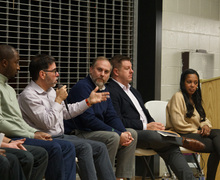City : Underrepresented: School board members inaccurately reflect district’s racial breakdown
Come Jan. 1, the Syracuse City School District’s school board will consist of six white members and only one black member.
Seven white candidates ran for the four available seats. Democrats William Bullen, Michelle Mignano, Max Ruckdeschel and Stephen Swift each received more than 7,500 votes on Nov. 8, enough to win seats on the board. The other three candidates each received between 5,000 and 5,700 votes during last week’s elections.
The nearly all-white school board will represent an increasingly diverse district.
Of the 19,961 students enrolled in the district, 53 percent are black and 28 percent are white, according to the school district’s website. Twelve percent are Latino, 6 percent are Asian and 1 percent are Native American or Alaskan, according to the website.
Two school board members don’t anticipate problems with the lack of diversity, although they disagree on why no candidates of color were nominated.
Syracuse’s seven-member school board has two black members: Calvin Corriders, who is completing his third term and decided not to run again, and Monique Wright-Williams, who is not yet up for re-election.
White members Laurie Menkin, Nancy McCarty and Ned Deuel all served at least eight years on the school board and decided against running again.
All the current board members are Democrats. The board will change from having three men and four women to consisting of four men and three women in 2012.
‘The questions of does the school board racial makeup currently align with the racial makeup of the student body, the answer to that is no,’ said Richard Strong, school board president. ‘But to perceive it as a problem, I think whether you have a good board or not does not depend on your racial makeup, but it depends upon what the board members are doing and how they’re working in unison with the superintendent.’
Nine Democrats sought the party’s endorsement for four open seats and three of the nine were people of color. None of them were nominated.
Strong said many people of color ran for the board, but some of them entered late and missed a valuable meeting in which they could’ve gathered support from large constituencies.
One of the black candidates for the school board had a good chance of getting the nomination, Strong said, but the candidate failed to attend the nominating committee meeting.
‘They had a travel schedule that they decided was more important than the nominating meeting and there you go,’ he said. ‘So that’s the whole story, this is the Paul Harvey moment. Throw the party down and beat up on everyone, but let’s look at the whole situation here and understand that it wasn’t all it was made out to be.’
Wright-Williams, who will be the sole black member of the school board, said she disagrees with Strong’s comment. One black candidate was not made aware of the date and time of the meetings, she said.
‘In fact, if I hadn’t called her, who knows if the party would’ve gotten back to her at all,’ Wright-Williams said.
Wright-Williams said there was still enough time for people to hear the candidate’s platform even with the missed meetings.
In terms of whether the nominating committee should’ve done a better job informing the candidates of the meetings, Strong said that’s for the Democratic Party leadership to decide.
‘I think it was an absolute travesty because there were qualified people of color there,’ Wright-Williams said.
Wright-Williams said the lack of diversity on the school board is more of a problem for the community.
‘It doesn’t have to be a problem in terms of the board’s functioning,’ she said. ‘The problem is that more people look like me than look like anybody else on that board and so the connections or the community — the ability to have natural insight — is gone.’
As long as members remember they represent all students, there shouldn’t be problems, Wright-Williams said. The problems will arise when students and their families look to the leadership and ‘do not see themselves,’ she said.
‘There’s nothing that can be done with that in terms of the board,’ Wright-Williams said. ‘It is what it is at this point.’
Published on November 15, 2011 at 12:00 pm
Contact Jon: jdharr04@syr.edu





